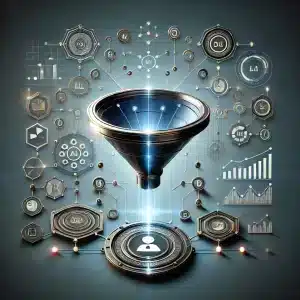In the rapidly evolving landscape of digital marketing, the importance of a well-structured sales funnel cannot be overstated. With the integration of artificial intelligence (AI) into sales funnel automation, businesses can significantly enhance their conversion rates and streamline their sales processes. This guide delves into the intricacies of creating an automated sales funnel, the tools available, and the strategies for maximizing your marketing efforts.
What is an Automated Sales Funnel and How Does it Work?
Defining the Automated Sales Funnel
An automated sales funnel is a systematic approach to guiding potential customers through the stages of the buying process, from awareness to decision-making. It uses automation tools to streamline interactions, ensuring that each lead receives tailored communication that addresses their specific pain points. Essentially, it integrates marketing and sales efforts to create a seamless experience for the customer, ultimately leading to increased sales and improved conversion rates.
Key Components of a Sales Funnel
The sales funnel comprises several key components that facilitate the journey of a potential customer. At the top of the funnel, awareness is generated through various marketing strategies, such as content marketing, social media, and paid advertising. As leads move down the funnel, they enter the consideration stage, where they evaluate options and begin to engage with your product or service. Finally, at the bottom of the funnel, leads are nurtured into making a purchase decision, aided by automated email campaigns and personalized offers. Understanding these stages is crucial for creating an effective automated sales funnel.
How Automation Enhances the Sales Process
Automation enhances the sales process by minimizing manual tasks, allowing sales teams to focus on high-value activities such as relationship building and closing deals. Through the use of sales funnel software, businesses can automate repetitive tasks like follow-up emails, scheduling, and lead scoring. This automation not only increases efficiency but also ensures that potential customers receive timely and relevant information at each stage of the funnel, which can significantly improve conversion rates.
How to Create an Automated Sales Funnel for Your Business?
Steps to Build an Automated Sales Funnel
Creating an automated sales funnel involves several steps. First, define your target audience and their specific pain points. Next, map out the customer journey, identifying key touchpoints where automation can be implemented. Following this, choose the appropriate sales funnel software that aligns with your business needs. Finally, create automated email campaigns and landing pages that guide leads through the funnel effectively. These steps are crucial for creating automated sales funnels that not only attract leads but also convert them into loyal customers.
Choosing the Right Sales Funnel Software
When it comes to choosing the right sales funnel software, it’s essential to consider factors such as ease of use, integration capabilities, and scalability. Tools like HubSpot offer comprehensive solutions that include marketing automation, customer relationship management, and sales funnel software tools all in one platform. Evaluate the features of various software options to find the one that best fits your business model and can grow with your needs.
Sales Funnel Software Tools You Need
To create an effective automated sales funnel, several software tools are indispensable. First, a sales funnel builder is necessary to visualize and manage the stages of your funnel. Additionally, email automation tools are vital for running effective email campaigns that reach your audience at the right time with the right message. Integrating customer relationship management (CRM) software can help track interactions and manage leads efficiently. Collectively, these tools will enable you to automate your sales funnel effectively.
What Are the Best Sales Funnel Software Options Available?
Comparison of Leading Sales Funnel Software
There are numerous sales funnel software options available, each with its unique features and benefits. For instance, ClickFunnels is popular for its user-friendly interface and sales funnel builder capabilities. On the other hand, Kartra offers advanced marketing automation features that are perfect for businesses looking to enhance their email marketing strategies. Comparing these leading options allows you to identify which software aligns best with your company’s specific needs.
Features to Look for in Sales Funnel Software
When evaluating sales funnel software, look for features that support your marketing automation goals. Essential features include customizable landing pages, automated email responses, lead scoring, and analytics for tracking performance. Additionally, integration capabilities with other marketing tools can enhance your overall marketing automation platform. Prioritizing these features will ensure that your sales funnel automation is both effective and efficient.
Benefits of Using the Best Sales Funnel Software
Utilizing the best sales funnel software can yield significant benefits for your business. By automating your sales funnel, you can streamline your sales process, improve lead management, and enhance customer engagement. This ultimately leads to higher conversion rates as potential customers receive timely information and nurture throughout their journey. Moreover, the insights gained from analytics can inform your marketing strategies, enabling you to make data-driven decisions that further increase sales.
How Can Marketing Automation Improve Your Sales Funnel?
Understanding Marketing Automation and its Benefits
Marketing automation refers to the use of software to automate marketing tasks and workflows. It plays a critical role in enhancing the sales funnel by delivering personalized content to leads based on their behaviors and preferences. This tailored approach helps address potential customers’ pain points more effectively, thereby increasing the likelihood of conversion. Additionally, marketing automation allows businesses to scale their marketing efforts without compromising on the quality of communication.
Integrating Email Marketing into Your Sales Funnel
Email marketing is a powerful tool in any automated sales funnel. By implementing email automation, businesses can create targeted email campaigns that nurture leads at various stages of the funnel. For instance, automated welcome emails can engage new subscribers, while follow-up emails can remind leads about abandoned carts or promote limited-time offers. The ability to send relevant content at the right moment significantly enhances the chances of converting leads into paying customers.
Using Automation Tools for Lead Generation
Effective lead generation is essential for a successful sales funnel. Automation tools can simplify this process by capturing leads through forms, chatbots, and landing pages. These tools can also segment leads based on their interactions with your content, allowing for more personalized outreach. By utilizing automation for lead generation, businesses can maintain a steady influx of potential customers while focusing their efforts on nurturing these leads through the sales process.
What Strategies Can Increase Conversion Rates in Your Sales Funnel?
Analyzing the Stages of the Funnel for Improvement
To increase conversion rates, it’s crucial to analyze the various stages of the funnel regularly. This analysis involves identifying where potential customers drop off and understanding the reasons behind their decisions. By evaluating the effectiveness of your landing pages, email campaigns, and overall communication, you can uncover valuable insights that inform necessary adjustments. Continuous improvement in each stage of the funnel ultimately leads to a more efficient sales process and higher conversion rates.
Best Practices for Nurturing Leads
Nurturing leads is an integral part of the sales funnel, and employing best practices can significantly enhance this process. Regularly updating your email lists, personalizing content based on user behavior, and providing valuable resources can keep leads engaged and interested. Additionally, segmenting your audience allows for more targeted communication, ensuring that potential customers receive information relevant to their stage in the funnel. These practices create a more meaningful connection with leads, increasing the chances of converting them into customers.
Utilizing Landing Pages to Boost Conversions
Landing pages are critical elements of the sales funnel that can dramatically boost conversions. A well-designed landing page focuses on a single call to action, minimizing distractions and guiding potential customers toward taking the desired action, whether it’s signing up for a newsletter, downloading a resource, or making a purchase. By optimizing landing pages for conversion, including compelling copy, clear visuals, and testimonials, businesses can significantly enhance their sales funnel effectiveness and drive higher conversion rates.




